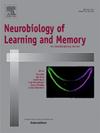How environmental enrichment influences conditioned taste aversion: A case of behavioral tagging
IF 1.8
4区 心理学
Q3 BEHAVIORAL SCIENCES
引用次数: 0
Abstract
Exposure to environmental enrichment (EE) has demonstrated a remarkable ability to modulate cognitive processes. These effects have been associated with brain-derived neurotrophic factor (BDNF), a protein recognized for regulating synaptic plasticity in the adult brain. Previous research from our group revealed that exposure to EE prior to the acquisition of a strong form of conditioned taste aversion (CTA) weakens the aversive response by restoring BDNF levels in the insular cortex (IC), a region in the temporal lobe involved in multimodal sensory integration and learning and memory processes. The behavioral tagging model offers a framework to explain how salient or novel events can strengthen weak memory traces encoded within critical time windows before or after the novel experience. However, to date, the effect of brief exposure to an enriched environment at the critical timeframe between the acquisition phase and the aversion test has not been fully clarified. The present study aimed to evaluate the effects of environmental enrichment on the strength of CTA memory, when the EE is presented during the period spanning from acquisition to aversion test. To do so, Wistar rats were exposed to environmental enrichment for seven days between the acquisition session and the CTA aversion test. Our results show for the first time that a brief exposure to an enriched environment can strengthen the aversive response of a weak CTA. Our results also show that the response strengthening is accompanied by a reduction in BDNF levels in the IC. These findings present evidence that an aversive memory response can be modified through innovative and complex behavioral manipulation, highlighting enriched environments as potential modulators of aversive memory within critical periods of memory processing.
环境富集如何影响条件味觉厌恶:一个行为标签的案例。
暴露于环境富集(EE)已经证明了一个显着的能力调节认知过程。这些作用与脑源性神经营养因子(BDNF)有关,BDNF是一种在成人大脑中调节突触可塑性的蛋白质。我们小组之前的研究表明,在获得强烈的条件性味觉厌恶(CTA)之前,暴露于情感表达会通过恢复岛叶皮层(IC)中的BDNF水平来减弱厌恶反应,岛叶皮层是颞叶中参与多模态感觉整合和学习记忆过程的区域。行为标记模型提供了一个框架来解释突出或新奇的事件如何加强在新奇经历之前或之后的关键时间窗内编码的弱记忆痕迹。然而,迄今为止,在收购阶段和厌恶测试之间的关键时间框架内,短暂暴露于丰富环境的影响尚未得到充分澄清。本研究旨在评价环境富集对情感表达在习得到厌恶阶段记忆强度的影响。为了做到这一点,Wistar大鼠在习得阶段和CTA厌恶测试之间暴露在环境富集环境中7天。我们的研究结果首次表明,短暂暴露于丰富的环境中可以增强弱CTA的厌恶反应。我们的研究结果还表明,反应增强伴随着IC中BDNF水平的降低。这些发现表明,厌恶记忆反应可以通过创新和复杂的行为操纵来改变,强调了在记忆加工的关键时期,丰富的环境是厌恶记忆的潜在调节剂。
本文章由计算机程序翻译,如有差异,请以英文原文为准。
求助全文
约1分钟内获得全文
求助全文
来源期刊
CiteScore
5.10
自引率
7.40%
发文量
77
审稿时长
12.6 weeks
期刊介绍:
Neurobiology of Learning and Memory publishes articles examining the neurobiological mechanisms underlying learning and memory at all levels of analysis ranging from molecular biology to synaptic and neural plasticity and behavior. We are especially interested in manuscripts that examine the neural circuits and molecular mechanisms underlying learning, memory and plasticity in both experimental animals and human subjects.

 求助内容:
求助内容: 应助结果提醒方式:
应助结果提醒方式:


